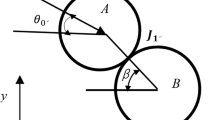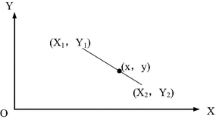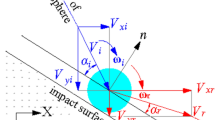Abstract
The trajectory of a rolling stone begins and is characteristically accompanied by a certain initial rotation. Considering the influence of the initial rotation, the four basic motion forms of a rolling rock movement are analyzed, based on contact mechanics and kinematics principles. The speed calculationF formulas for a rolling rock mass were obtained. Besides, taking the dangerous rock slope of Changheba Hydropower Station in Sichuan Province as an example, the entire moving process of a rolling stone was simulated using “Rocfall software”, and the influence of an initial rotation on total kinetic energy, bounce height, and trajectory of the rolling stone during the movement was analyzed. According to the results, the determination of the most dangerous position during the movement of the rolling stone is not be affected by the initial rotation angular velocity. However, the maximum bounce height of the rolling stone at the most dangerous position increases with the increase of the initial rotation; the initial rotation of a rolling stone affects the longest distance and total horizontal distance. The probability density distribution of total kinetic energy and horizontal distance followed the Gaussian distribution; the influence of initial rotation on the central value can not be ignored. In this case, if the rotation was ignored, the rockfall disaster range would be underestimated, the rate can reach up to 94% when \(\omega =200\hbox {rad/s}\). The initial rotation of a rolling stone has a different sensitivity to the slope characteristics. The smooth and hard surface was the most sensitive. The larger the angular velocity, the more sensitive the slope. Therefore, the influence of a rocking stone rotating velocity and slope surface material must be considered in investigating the trajectory of the rockfalls and the provision of protective measures.












Similar content being viewed by others
Data availability
The data used to support the findings of this study are available from the corresponding author upon request.
Change history
13 December 2021
A Correction to this paper has been published: https://doi.org/10.1007/s10706-021-02035-z
References
Asteriou P, Tsiambaos G (2016) Empirical Model for Predicting Rockfall Trajectory Direction. Rock Mech Rock Eng 49(3):927–941
Chen TJ, Zhang GC, Zhang C, Gao X, Zheng Y (2019) Normal Impact Test of a Spherical Rockfall. Geotech Geol Eng 37(6):4889–4899
Chau KT, Wong RHC, Wu JJ (2002) Coefficient of restitution and rotational motions of rockfall impacts. Int J Rock Mech Mining Sci 39(1):69–77
Depountis N, Nikolakopoulos K, Kavoura K, Sabatakakis N (2020) Description of a GIS-based rockfall hazard assessment methodology and its application in mountainous sites. Bulletin Eng Geol Environ 79(2):645–658
Dong H, Moys MH (2006) Experimental study of oblique impacts with initial spin. Powder Technol 161:22–31
Duan SZ, Sun JL (2020) Exploration of Probability Distribution of Velocities and Trajectory of Rolling Stone Based on Stochastic Rolling Stone Collision. Geotech Geol Eng 38:3931–3940
Ferrari F, Giacomini A, Thoeni K (2016) Qualitative rockfall hazard assessment: a comprehensive review of current practices. Rock Mech & Rock Eng 49(7):2865–2922
Huang RQ, Liu WH, Zhou JP, Pei XJ (2010) Experimental field study of movement charateristics of rock blocks falling down a slope. J Earth Sci 21(3):330–339
Hu J, Li SC, Shi SS, Hu J, Li SC, Shi SS, Zhang Q, Liu HL, He P (2018) Experimental study on parameters affecting the runout range of rockfall. Adv Civil Eng (PT.2):1–9
He SM, Wang DP, Wu Y, Ouyang CJ (2014) Mechanics mechanism and prevention and control technology of rockfall disaster. Nature 36(05):336–345
Hu HT (1989) Collapse and Falling Rocks. China Railway Publishing House, Beijing (in Chinese)
Huang RQ, Liu WH (2009) Experimental study on stoppage effect of platform on rolling stone. J Rock Mech Eng 28(03):516–524 (in Chinese)
Kawahara S, Muro T (2006) Effects of dry density and thickness of sandy soil on impact response due to rockfall. J Terramech 43(3):329–340
Kobayashi Y, Harp EL, Kagawa T (1990) Simulation of rockfalls triggered by earthquakes. Rock Mech Rock Eng 23(1):1–20
Kohno M, Tsuchida A, Kitasako K, Ikezoe Y, Nishimura T (2016) Laboratory experiment and numerical analysis of rockfall impacts. J Soc Mater Ence Japan 65(5):377–383
Labiouse V, Descoeudres F, Montain S (1996) Experimental study of rocksheds impacted by rock blocks. Struct Eng Int 6(3):171–176
Laimer HJ (2020) Determination of rockfall design blocks in Upper Triassic limestones and dolomites (Dachstein Formation, Northern Calcareous Alps). Bulletin Eng Geol Environ 79(3):1581–1590
Liao XH, Wang XL, Li LH, Liu HY, Yang ZF, Chen ZG, Ivorra B (2020) Engineering Application and Prediction of the Influence Area of the Rockfall Hazards. Mathemat Prob Eng 2020:1–14
Lv Q, Sun HY, Zhai SK, Wang HB, Shang YQ (2003) Evaluation models of rockfall trajectory. J Natural Disasters 12(2):79–84 (in Chinese)
Nagendran SK, Ismail MAM (2019) Analysis of Rockfall Hazards Based on the Effect of Rock Size and Shape. Int J Civil Eng 17(12):1919–1929
Polat A, Keskin I, Denizli I (2016) Preventing and analysis of falling rocks: A case of Sarica village (Gürün, Turkey). J Geol Soc India 88(6):763–772
Scavia C, Barbero M, Castelli Marchelli M (2020) Vallero G (2020) Evaluating Rockfall Risk: Some Critical Aspects. Geosciences (Switzerland) 10(3):98
Su Y, Choi C (2020) Effects of rock shape on the cushioning mechanics of rock-filled gabions. Acta Geotechnica 16(4):1043–1052
Sun SQ, Li SC, Li LP, Shi SS, Wang J, Hu J, Hu C (2019) Slope stability analysis and protection measures in bridge and tunnel engineering: a practical case study from Southwestern China. Bullet Eng Geol Environ 78(5):3305–3321
Thornton C (2009) A note on the effect of initial particle spin on the rebound behaviour of oblique particle impacts. Powder Technol 192(2):152–156
Tang HM, Yi PY (2003) Study on the path of rockfall movement of dangerous rocks. J Chongqing Jianzhu Univ (in chinese)
Yang HQ, Zhou XP (2009) A new approachto calculate trajectory of rockfall. Rock Soil Mech 30(11):3411–3416
Yilmaz I, Yildirim M, Keskin I (2008) A method for mapping the spatial distribution of RockFall computer program analyses results using ArcGIS software. Bullet Eng Geol & the Environ 67(4):547–554
Yoon J, Ban H, Hwang Y, Park D (2020) Mitigation method of rockfall hazard on rock slope using large-scale field tests and numerical simulations. Adv Civil Eng. https://doi.org/10.1155/2020/3610651
Zhang GC, Xiang X, Tang HM (2011) Field Test and Numerical Calculation of Recovery Coefficient of Rockfall Impact. Chinese J Rock Mech Eng 30(6):1266–1273
Zhang SL, Yang XG, Zhou JW (2018) A theoretical model for the estimation of maximum impact force from a rockfall based on contact theory. J Mountain Sci 15(002):430–443
Zhang YH, Zhang MX, Chen Q, Luo K (2017) Kinematics analysis for calculating distance of rockfalls on typical loose media slope. Journal of Shanghai University(Natural Science Edition)
Acknowledgements
This study was supported by the National Natural Science Foundation of China (Grant no. 11702124), Doctor Funding of Lanzhou University of Technology (Grant no. 04-061407). The authors would like to express their sincere appreciation to these supports.
Author information
Authors and Affiliations
Contributions
Shaozhen Duan: Conceptualization, Methodology, Funding acquisition, Writing-original draft
Wei Jin: Software, Data curation, Validation, Formal analysis, Writing-review & editing
Jinlong Sun: Investigation, Data curation, Project administration, Visualization
Wenda Wang: Writing-review & editing, Supervision, Project administration
Corresponding author
Ethics declarations
Conflict of interest
The authors declare that they have no known competing financial interests or personal relationships that could have appeared to influence the work reported in this paper.
Additional information
Publisher's Note
Springer Nature remains neutral with regard to jurisdictional claims in published maps and institutional affiliations.
Rights and permissions
About this article
Cite this article
Duan, S., Jin, W., Sun, J. et al. Trajectory Analysis of the Rockfall Based on the Effect of Rotating Angular Velocity. Geotech Geol Eng 40, 121–131 (2022). https://doi.org/10.1007/s10706-021-01863-3
Received:
Accepted:
Published:
Issue Date:
DOI: https://doi.org/10.1007/s10706-021-01863-3




